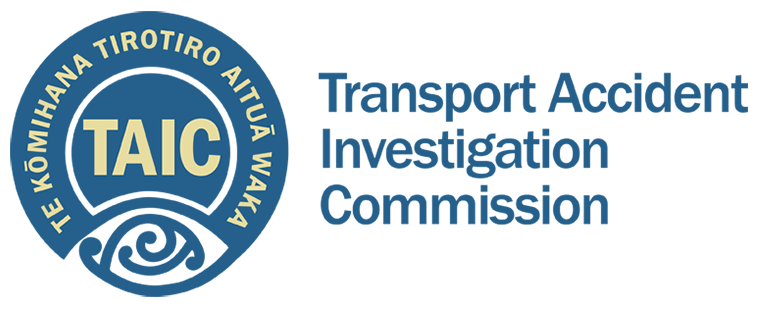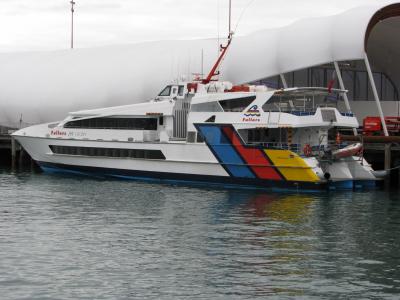Passenger ferry Jet Raider, catastrophic engine failure, Hauraki Gulf, 27 August 2011
Status
Closed
Occurrence Date
Report Publication Date
Jurisdiction
NZ
On 27 August 2011 the Jet Raider was making a trip from Auckland to Waiheke Island in the Hauraki Gulf with 5 crew and 316 passengers on board. At about 11:20 the starboard engine failed catastrophically when 2 engine connecting rods broke free of the crankshaft and were ejected through the engine casing.
The escaping mixture of fuel and exhaust gases, and possibly steam resulting from damage to the cooling water system, set off the fire alarms and gave the crew the appearance on the closed-circuit television that a fire had occurred. The crew shut down the engines, sealed the engine compartment and released the fixed engine room carbon dioxide (CO2) fire-suppression system. Meanwhile the skipper raised the alarm and anchored the ferry in the Motuihe Channel.
The passengers were transferred to another company ferry that had been following close behind. Nobody was injured, but the starboard engine was a total constructive loss.
The investigation found that no fire had occurred, but a momentary flash-off caused by the ignition of a vaporised fuel and exhaust gas mixture from the damaged engine might have occurred.
The engine failure was caused by the overload failure of the bolts clamping the big ends of number 4 connecting rods to the crankshaft. Owing to the damage sustained to engine components it was not possible to determine what initiated the sequence of engine component failures. A number of possibilities are discussed.
There was no evidence of poor maintenance procedures contributing to the catastrophic engine failure. However, the Jet Raider was being used as a standby vessel to support the main passenger fleet. Consequently it had a low annual number of operating hours. The engine manufacturer had recommended a shorter interval between replacements of some engine components for this type of operation. Fullers Group Limited (Fullers) was not following that recommendation, but it could not be determined whether that contributed to this failure because the engine manufacturer would not explain the rationale behind its recommendation.
Two safety issues were identified:
- transferring passengers to another vessel as a form of abandoning ship was the usual method employed by ferry operators in the Hauraki Gulf because of the high probability of another passenger vessel being in the vicinity. However, this method was not considered during emergency response training, and no thought had been given to small modifications in ferry design that could reduce the risk to passengers during such an event
- when the fixed engine room CO2 fire-suppression system was used, only half of the required CO2 gas was released to the engine room. Part of the reason was a lack of clear placarding to highlight the differences in procedures between mono-hull ferries with single engine rooms and catamaran-style ferries with split engine rooms.
Neither of these safety issues affected the outcome of this accident, but recommendations have been made to prevent their affecting outcomes under different circumstances in future.
Key lessons that can be taken from this inquiry are:
- training for emergency responses must cover the procedures for using mandatory lifesaving equipment, but should also be extended to cover other common scenarios, such as using a ship-to-ship transfer of passengers when abandoning ship
- instruction placards for critical systems such as fixed engine room CO2 fire-suppression systems should be clear and concise to avoid operators misinterpreting them at times of high or stressful workload.
The escaping mixture of fuel and exhaust gases, and possibly steam resulting from damage to the cooling water system, set off the fire alarms and gave the crew the appearance on the closed-circuit television that a fire had occurred. The crew shut down the engines, sealed the engine compartment and released the fixed engine room carbon dioxide (CO2) fire-suppression system. Meanwhile the skipper raised the alarm and anchored the ferry in the Motuihe Channel.
The passengers were transferred to another company ferry that had been following close behind. Nobody was injured, but the starboard engine was a total constructive loss.
The investigation found that no fire had occurred, but a momentary flash-off caused by the ignition of a vaporised fuel and exhaust gas mixture from the damaged engine might have occurred.
The engine failure was caused by the overload failure of the bolts clamping the big ends of number 4 connecting rods to the crankshaft. Owing to the damage sustained to engine components it was not possible to determine what initiated the sequence of engine component failures. A number of possibilities are discussed.
There was no evidence of poor maintenance procedures contributing to the catastrophic engine failure. However, the Jet Raider was being used as a standby vessel to support the main passenger fleet. Consequently it had a low annual number of operating hours. The engine manufacturer had recommended a shorter interval between replacements of some engine components for this type of operation. Fullers Group Limited (Fullers) was not following that recommendation, but it could not be determined whether that contributed to this failure because the engine manufacturer would not explain the rationale behind its recommendation.
Two safety issues were identified:
- transferring passengers to another vessel as a form of abandoning ship was the usual method employed by ferry operators in the Hauraki Gulf because of the high probability of another passenger vessel being in the vicinity. However, this method was not considered during emergency response training, and no thought had been given to small modifications in ferry design that could reduce the risk to passengers during such an event
- when the fixed engine room CO2 fire-suppression system was used, only half of the required CO2 gas was released to the engine room. Part of the reason was a lack of clear placarding to highlight the differences in procedures between mono-hull ferries with single engine rooms and catamaran-style ferries with split engine rooms.
Neither of these safety issues affected the outcome of this accident, but recommendations have been made to prevent their affecting outcomes under different circumstances in future.
Key lessons that can be taken from this inquiry are:
- training for emergency responses must cover the procedures for using mandatory lifesaving equipment, but should also be extended to cover other common scenarios, such as using a ship-to-ship transfer of passengers when abandoning ship
- instruction placards for critical systems such as fixed engine room CO2 fire-suppression systems should be clear and concise to avoid operators misinterpreting them at times of high or stressful workload.
Location
Motuihe Channel, Hauraki Gulf (-36.794200,174.933300) [may be approximate]

